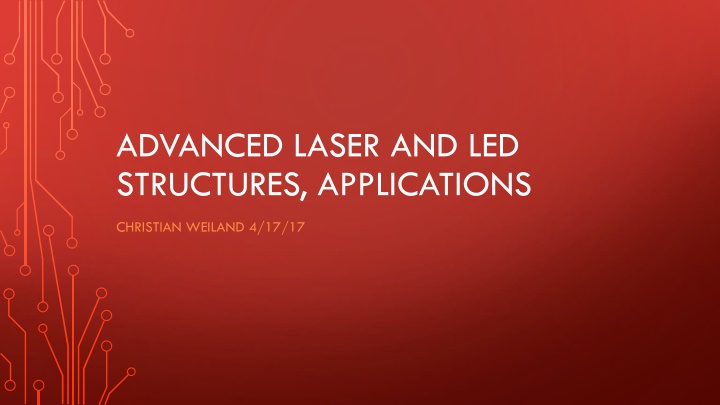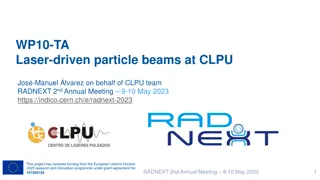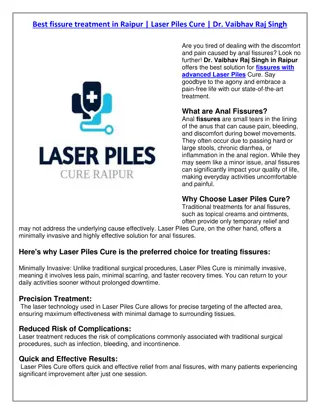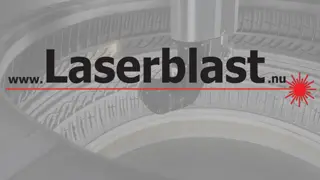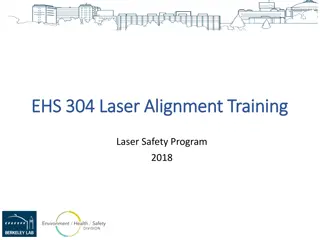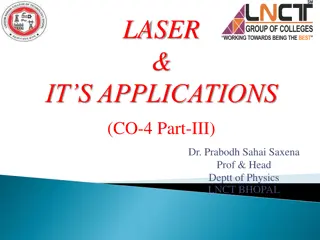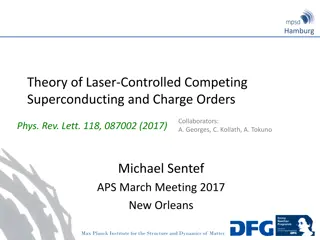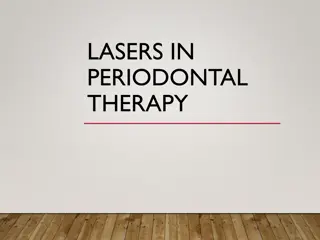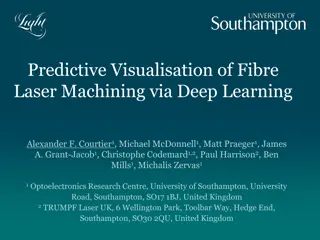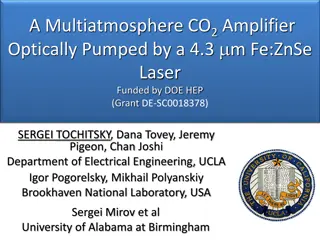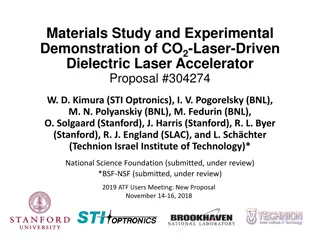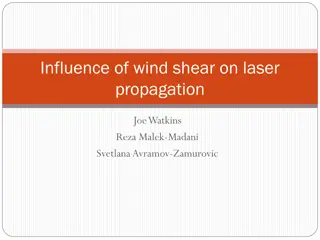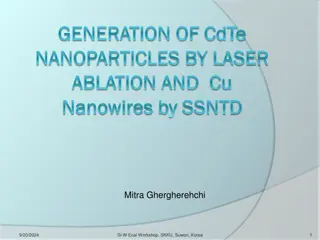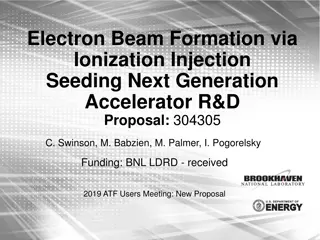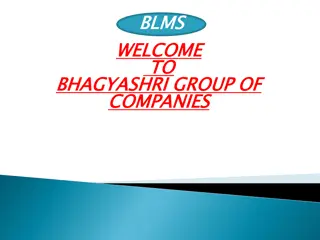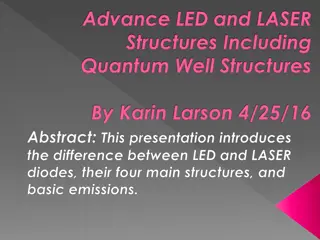Advanced LED and Laser Structures for Various Applications
Exploring the definitions, structures, and working principles of LEDs and lasers, this content delves into Quantum Well structures, different types of LEDs and lasers, and their applications. It covers LED categories, Surface Emitting LEDs, Edge Emitting LEDs, and Superluminescent Diodes, detailing their characteristics, uses, and advantages. A comprehensive guide for those interested in advanced lighting and technology.
Download Presentation

Please find below an Image/Link to download the presentation.
The content on the website is provided AS IS for your information and personal use only. It may not be sold, licensed, or shared on other websites without obtaining consent from the author.If you encounter any issues during the download, it is possible that the publisher has removed the file from their server.
You are allowed to download the files provided on this website for personal or commercial use, subject to the condition that they are used lawfully. All files are the property of their respective owners.
The content on the website is provided AS IS for your information and personal use only. It may not be sold, licensed, or shared on other websites without obtaining consent from the author.
E N D
Presentation Transcript
ADVANCED LASER AND LED STRUCTURES, APPLICATIONS CHRISTIAN WEILAND 4/17/17
OUTLINE Definition of LEDs and LASERs and what they do Explanation of the Quantum Well structure Different types and variants of LEDs and LASERs and their structures How the structures are made and how they work Specifications, advantages, disadvantages, applications
LED P-n junction Electroluminescent Small, long lifetime, low power consumption LED home lighting bulbs are now cheaper than fluorescent lamps Grown epitaxially (liquid or vapor) Substrate lattice meant to match active layer (GaAs, GaP, InP) Used for lighting, traffic signals, headlamps, aviation navigation lights
LED CATEGORIES Low Current 2 mA, 2 V Standard 20 mA, 1.9-4.2 V (depending on color) Ultra-High-Output 20 mA, 2 or 4-5 V (can be seen in direct sunlight)
SURFACE EMITTING LED (SLED) Light emitted perpendicular to the junction plane Emits light over a wide angle High radiance from restricting emission to the active region Etched well prevents heavy absorption of emitted light Low thermal impedance in the active regions allows for high radiance emission into the optical fiber The primary active region, where photons are emitted, has a diameter of 20-50 m 250 Mb/s
EDGE EMITTING LED (ELED) Light emitted parallel to junction plane Light confined to a narrow angle provides better coupling High radiance Used in optical communications Can be used for single mode and multimode fiber systems Active region is a stripe that runs through the device. The polished ends are called facets. Light is emitted through the front facet while the back facet is highly reflective. While ELEDs have a smaller spectral range than SLEDs, they couple more power into the optical fiber and can be modulated up to 400 Mb/s can couple 5-6 times more power
SUPERLUMINESCENT DIODE (SLD) Edge emitting diode that uses superluminescence https://www.ecse.rpi.edu/~schubert/Light-Emitting-Diodes-dot-org/chap23/F23-09%20SLD%20structures.jpg Produces high power and brightness like a laser with the low coherence of an LED Emission band of 5-100 nm Peak wavelength and intensity depend on material composition andinjection current Used include medical imaging and gyroscope componenets
ORGANIC LED OLED digital displays AMOLED better size, resolution PHOLED - phosphorescent
LASER DIODE Laser diodes are semiconductor diodes that are pumped with current at the p-n junction Direct band gap semiconductor Used for laser pointers, DVD readers, optical communications, barcodereaders, laser surgery, DNA sequencing technology Functionality of a specific laser type depends on its qualities. For example, high coherency is good for distance measurement and narrow spectral qualities are good for telecommunications and spectroscopy Common materials include GaAs, AlGaAs, GaP, InGaP, GaN, InGaAs, GaInAs, InP, GaInP
QUANTUM WELL Potential well with energy levels Thin layer confining electrons and holes Material embedded between two semiconductor layers of a larger band gap Typically 5-20 nm thick Fabricated with MBE or MOVPE Used as waveguides in laser diodes Multiple can be used for high optical gain
DOUBLE HETEROSTRUCTURE LASER https://upload.wikimedia.org/wikipedia/commons/thumb/9/93/Simple_dh_laser_diode.svg/350px-Simple_dh_laser_diode.svg.png The active region, where electrons and holes coexist, is confined to the thin middle region increased amplification Light is reflected from the heterojunction, meaning it is confined to where amplification occurs
QUANTUM WELL LASER Highly efficient because electrons are concentrated in energy states that contribute to the laser https://upload.wikimedia.org/wikipedia/en/thumb/4/42/Simple_qw_laser_diode.svg/350px-Simple_qw_laser_diode.svg.png Wavelength of light determined by the width of the active region, not just the band gap Even better efficiency with quantum wire and quantum dots
QUANTUM CASCADE LASER Laser consisting of quantum well heterojunctions Achieves laser emission through intersubband transition Light as amplified at long wavelengths which is affected by the thickness of the quantum well layer Mid-infrared produced by the laser is helpful for imaging and detection of things like explosives and toxins
INTERBAND CASCADE LASER Mid-infrared region of the electromagnetic spectrum Made from layers of InAs, GaSb, and AlSb Uses interband transitions instead of intersubband transitions Used for spectroscopic sensing
SEPARATE CONFINEMENT HETEROSTRUCTURE LASER https://upload.wikimedia.org/wikipedia/commons/thumb/c/c6/Simple_sch_laser_diode.svg/350px-Simple_sch_laser_diode.svg.png Quantum wells cannot confine light effectively Two more layers with a lower refractive index are added This diode is the type of almost every laser that is commercially available
DISTRIBUTED BRAGG REFLECTOR LASER Single frequency laser Has an optical cavity with a gain region between two mirrors that provide feedback One mirror is wavelength selective with a diffraction grating and high reflectivity
DISTRIBUTED FEEDBACK LASER Type of quantum cascade laser Single frequency laser Diffraction grating close to the p-n junction that filters out a single wavelength and feeds it back to the active region Facets are AR coated because reflection is unnecessary Used in optical communications Threshold Current 11 mA Bias Current 50 mA
VCSEL Single frequency Optical cavity in the direction of current flow Short active region length so that light emits from the surface of the cavity https://upload.wikimedia.org/wikipedia/commons/thumb/c/c8/Simple_vcsel.svg/350px-Simple_vcsel.svg.png VCSELs can be tested on the wafer which reduces fabrication costs Wavelength typically 650-1300 nm can be longer with InP active region which is good but high reflectivity causes lower output power than edge emitting lasers Low power consumption and long lifetime because facets can t be damaged by intensity but low power production due to high reflectivity Used in spectroscopy, laser printing, and computer mice
VECSEL No p-n junction One of the mirrors is on the outside of the structure, 1 cm from the diode Semiconductor gain region is less than 100 nm which is much smaller than other semiconductor lasers The waveguiding provided by the short propagation length cannot be provided by edge-emitting lasers Industrial machines use them for their high power output
EXTERNAL-CAVITY DIODE LASER Wavelength can be tuned by rotating the diffraction grating Usually are heterostructure diodes made of AlGaAs Output beam is in a fixed direction but diffraction reduces the power output Used as a data transmitter for optical communications
SUMMARY LEDs and LASERs are either edge-emitting or surface-emitting Epitaxy is an important process in the fabrication of optoelectronics Generally, LEDs emit low power light incoherently while LASERs emit high power light in a coherent beam Light is usually emitted from the p-n junction of these devices Quantum wells are a type of heterostructure crucial to the design of LASERs Wavelength and power output are important factors for decided how to use an LED or LASER
REFERENCES https://www.rp-photonics.com/semiconductor_lasers.html https://www.hft.tu-berlin.de/fileadmin/fg154/ONT/Skript/ENG-Ver/HL- STRUK_31_10.pdf http://www.radio-electronics.com/info/data/semicond/leds-light-emitting- diodes/structure-fabrication.php http://ggnindia.dronacharya.info/ECEDept/Downloads/QuestionBank/VIIsem/oc_C- Unit-3-LED_Structures.pdf https://www.rp-photonics.com/light_emitting_diodes.html http://ieeexplore.ieee.org/document/1480162/ http://www.theverge.com/circuitbreaker/2017/2/4/14507712/led-light-bulbs- good-idea http://www.daylightsolutions.com/technology/qcl_technology.htm
KEY POINTS Edge-emitting diodes emit light perpendicular to the junction plane and produce high output power while surface-emitting diodes emit light parallel to the junction plane and have a high range of wavelength Epitaxy is the deposition of overlayer onto a substrate that can be done either chemically or physically Stimulated emission occurs when a photon at a certain frequency interacts with an excited electron and drops to a lower energy level The thinnest LED in existence is 3 atoms thick A heterojunction involves a semiconductor material being in contact with another material of a different band gap
